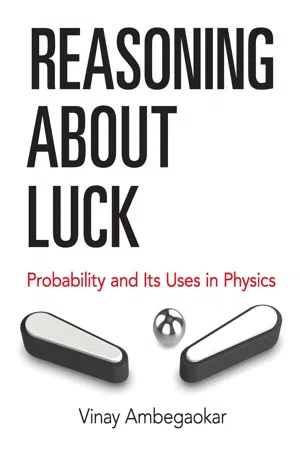Physics
Acceleration Due to Gravity
Acceleration due to gravity is the rate at which an object accelerates towards the Earth due to gravity. Near the surface of the Earth, this acceleration is approximately 9.81 meters per second squared. It is a constant value for a given location and is a fundamental concept in physics, influencing the motion of objects in free fall.
Written by Perlego with AI-assistance
Related key terms
4 Key excerpts on "Acceleration Due to Gravity"
- eBook - ePub
- David G. Newman(Author)
- 2016(Publication Date)
- Routledge(Publisher)
PART IMechanics of GPassage contains an image
Chapter 1The Physics of Gravity
Humans exist in a gravity-dependent environment. In order to fully appreciate the physiological consequences of human exposure to high-gravitational forces, it is useful first to have a thorough understanding of what is meant by the terms gravity and acceleration, since they will be used frequently throughout this book. This chapter will examine the mathematics and physics underlying these important terms.Mechanics
Initially, it is helpful to define some important terms in mechanics that will be used repeatedly throughout this book. Speed is the term used to denote a change in distance with respect to time. It is a scalar quantity, reflecting magnitude only. When both the magnitude and direction of change in distance with time are considered, the term velocity is used rather than speed. Velocity is a vector quantity. When velocity experiences a rate of change with respect to time, acceleration is said to have occurred. It can also be thought of as the second derivative of distance with respect to time. Acceleration is of course also a vector quantity, having both magnitude and direction. The magnitude of acceleration, and the direction in which it is applied, will be examined in more detail in Chapter 2 .The terms speed, velocity, acceleration and force (to be discussed later with Newton’s Laws of Motion) are straightforward terms. Unfortunately, in many cases they are used interchangeably and in the wrong technical sense. This is worth briefly discussing, for the sake of clarity. Speed and velocity are often used to represent the same thing, which as has been seen above, is not technically correct. One is a scalar quantity, the other is a vector. In many cases, speed is used when velocity might be the more correct term. In the lexicon of acceleration physiology, the terms force and acceleration are also very often used interchangeably. This can create some confusion on the part of readers, particularly those new to the field. The situation is made worse when the terms G force and G acceleration are used on an interchangeable basis. Ultimately, it does not matter which term is used, as long as there is some consistency. As readers will see in later sections of this chapter, the interchangeable use of force and acceleration is a by-product of one of Newton’s Laws of Motion – force and acceleration are proportional to each other. In this book, the term G force will be used to represent the force applied to a body undergoing an acceleration. This will become clearer as this chapter develops. - eBook - ePub
- Vinay Ambegaokar(Author)
- 2017(Publication Date)
- Dover Publications(Publisher)
It is worth pointing out that this constant can be measured in the laboratory ‡ by measuring the force between massive objects. The constant is found to be 6.67×10 –11 in mks units – force in newtons, distances in meters, and masses in kilograms. It is then fascinating that the equation for the Acceleration Due to Gravity, g, obtained by eliminating F a from (6.9) and (6.11), allows one to calculate the mass of the earth from its radius, the Acceleration Due to Gravity, and the gravitational constant! The answer is close to 6×10 24 Kg. Newton’s mechanics not only explained the motion of ordinary objects on the earth, and of celestial bodies, but it left as a more general legacy the concept of Energy, which turns out to be central to a discussion of heat. To this we now turn. Energy When an apple is falling towards the earth, nothing about its state of motion appears, at first sight, to be remaining the same. Its velocity, after all, is increasing, and its height above the surface of the earth is decreasing as time passes. It is, however, possible to view the fall of the apple as a process in which something called energy is being changed from one form to another, while itself remaining constant. Energy is one of what are called ‘constants of the motion’ in Newton’s mechanics. Abstract and perhaps artificial though this concept seems, energy has become a common thread that runs through all branches of physics. It is possible to view each great advance in our understanding of the physical world since Newton’s time as the identification of a new form of energy - eBook - ePub
Doing Physics with Scientific Notebook
A Problem Solving Approach
- Joseph Gallant(Author)
- 2012(Publication Date)
- Wiley(Publisher)
If the displacement and velocity have the same sign, the object is moving away from the origin. If they have opposite signs, the object is moving toward the origin.Table 2.2 summarizes the sign information for velocity and acceleration for horizontal motion.Table 2.2
If the velocity and the acceleration have the same sign, the object’s speed is increasing. If they have opposite signs, the object is slowing down. For vertical motion, just replace the word “right” with “up” and replace the word “left” with “down” in both tables.Velocity Acceleration Interpretation Positive Positive Moving right, speed increasing Positive Negative Moving right, speed decreasing Negative Positive Moving left, speed decreasing Negative Negative Moving left, speed increasing Free Fall
One famous and important example of constant acceleration motion is the motion of an object under the influence of gravity near the Earth’s surface. This vertical acceleration is a = - g where g = 9.8067 m/ s2 is the acceleration’s magnitude and the minus sign indicates gravity acts down. Because the Acceleration Due to Gravity is approximately constant, all objects fall at the same constant rate.When gravity is the only force acting on an object, we say it is in free fall. As long as the object is not too light or moving too fast, air resistance is negligible and gravity determines its motion. An object is in free fall as soon as it is released, whether it is dropped or thrown, whether it is going up or down.We can apply Eqs. (2.5) to this problem. To distinguish horizontal motion from vertical, let’s rewrite the equations of motion letting y denote vertical position (height). When you change x → y and let a = - g, you have the following four equations.(2.6a)(2.6b)(2.6c)(2.6d)These four equations describe the motion of an object that is dropped or thrown straight up or down under the influence of gravity with negligible air resistance. They relate the object’s height and vertical velocity to the Acceleration Due to Gravity and the time, with up as positive and down as negative. - eBook - ePub
- AlanJoel Witten(Author)
- 2017(Publication Date)
- Routledge(Publisher)
Fig. 2.11 , can be implemented with a gravimeter. The only modification to this concept is that, like bathroom scales, gravimeters measure only the vertical component of gravitational force. It is now well known that forces are vectors and, since mass is a scalar, the direction of a force is along the direction of the acceleration. This makes acceleration a vector and, consequently, gravimeters only measure the vertical component of the gravitational acceleration. Figure 2.18a shows a gravimeter located directly above a localized region having a density different from its surroundings, △ρ, at a depth d below the ground surface. Recalling from Equation 2.13 thatΔ F = Δ ρ ,G m Vr 2where r is the distance from the density difference to the measurement, so thatΔF d= m Δ g = Δ ρ ,G m Vd 2and dividing both sides of this by the mass fixed to the gravimeter m yieldsEquation 2.18:Δ g ==ΔmF dΔ ρ ,G m Vd 2where △g is the measured change in gravitational acceleration. Because the direction of the change in gravitational acceleration is along the direction from the anomalous density to the measured point, in this case, △g is vertical. This could be vertically downward or vertically upward depending on whether the density change is positive or negative; however, the vertical component of the change in gravitational acceleration is equal to the change in gravitational acceleration, △gz= △g. When the measurement point is moved laterally away (Fig. 2.18b ), the change in gravitational force decreases as a result of the increased distance, from d to R,
Learn about this page
Index pages curate the most relevant extracts from our library of academic textbooks. They’ve been created using an in-house natural language model (NLM), each adding context and meaning to key research topics.



